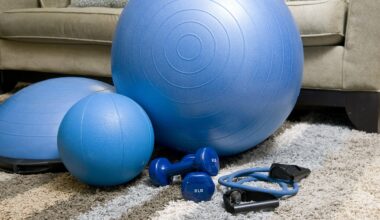How to Use Sandbags for Functional Bootcamp Training
Sandbags are becoming increasingly popular in bootcamp training due to their versatility and ability to mimic real-life lifting situations. Their unique design enables users to engage stabilizing muscles, which is crucial in functional strength training. To start, select a weight that is challenging yet manageable for your fitness level. Begin with lighter sandbags, gradually increasing the weight as your strength improves. This approach ensures proper form and reduces the risk of injury. Sandbags can be used for a variety of exercises, including squats, lunges, and carries, which promote overall functional strength. It’s essential to maintain a neutral spine during these movements, keeping your core engaged. To maximize the effectiveness, vary your workouts by incorporating different exercises that target various muscle groups. Additionally, combining sandbags with other equipment, like kettlebells or resistance bands, can create a more diverse routine. Experiment with different configurations and weights to keep the workouts fresh and challenging. Incorporating sandbags into your bootcamp routine not only improves strength but also enhances endurance and stability, benefiting overall athletic performance.
Benefits of Using Sandbags
There are numerous benefits to incorporating sandbags into your bootcamp training. First, they promote balanced muscle development because they shift weight as you lift them, forcing your body to adapt. This instability encourages the use of smaller stabilizing muscles, improving overall strength and coordination. Another advantage is that sandbags are relatively inexpensive compared to other types of gym equipment. They can be made at home or purchased online for a fraction of the cost. Moreover, sandbags are highly portable, making it easy to take your workout outdoors or to different locations. They require minimal storage space, which is perfect for those with limited space at home. Additionally, using sandbags can enhance functional fitness, which translates directly into better performance in everyday activities. The exercises you perform with sandbags mimic real-world movements, such as lifting heavy objects. This functional training is crucial for athletes and anyone looking to improve life skills. Furthermore, sandbags are suitable for all fitness levels, as they can be easily adjusted based on your strength and endurance. This adaptability makes them an accessible choice for bootcamp training.
When using sandbags, it is vital to focus on proper technique to avoid injury and maximize the benefits. Start with foundational movements, like deadlifts and overhead presses, before progressing to more complex exercises. Both beginners and seasoned athletes should prioritize alignment and posture. Always warm up before lifting to prepare your muscles and joints for the workout. Incorporating mobility exercises can enhance flexibility and prevent stiffness. After your workout, consider cooling down with stretching to improve recovery. Working in a dynamic warm-up helps increase blood flow, directly impacting your performance. If possible, consult a trainer or watch instructional videos that demonstrate key movements to ensure you grasp proper techniques. Pay attention to your breathing as well, as exhaling during exertion can enhance strength. Lastly, tracking your progress by noting workout details can help you understand your improvements over time. Logging your weight, repetitions, and areas of difficulty allows for effective adjustments in your routine. Regularly evaluate your goals to ensure your practices align with your fitness objectives. With the right approach, sandbags can become an essential part of your functional bootcamp training.
Essential Sandbag Exercises
There are several essential exercises you should include in your bootcamp training when working with sandbags. One effective exercise is the sandbag clean and press, which involves lifting the bag from the ground to shoulder height and then pressing overhead. This full-body movement develops explosive power and engages multiple muscle groups. Another great exercise is the sandbag squat, where you can hold the bag at shoulder level while performing a squat. This variation of the squat targets your lower body while challenging your core stability. Carrying the sandbag, either in a bear hug style or on one shoulder, also enhances grip strength and core control. Lunges can be intensified by holding the sandbag, providing an extra challenge for both balance and strength. You might also want to incorporate rotational movements, such as the sandbag rotational lift, to engage the obliques and improve overall core strength. Finally, don’t forget to add some burpees with the sandbag to boost your heart rate. These exercises provide a comprehensive workout that effectively targets various muscle groups and energy systems.
To prevent injuries while using sandbags in your bootcamp training, ensuring proper warm-ups is vital. A well-rounded warm-up prepares your body for intense exertion, activating muscles and increasing your heart rate. Specific dynamic stretches focusing on the shoulders, hips, and legs will facilitate a better range of motion. During your workout, concentrate on your form and breathing; poor control can lead to strains. If you feel unstable or fatigued, don’t hesitate to lower the weight or lessen the repetitions. Listening to your body ensures you maintain a safe and effective workout. Adequate recovery time is equally important; allow your muscles to heal and grow stronger by refraining from work when you feel overly fatigued. Incorporating rest days or lighter training sessions promotes long-term progress. Hydration plays a crucial role in injury prevention as well, so drink plenty of water before, during, and after your workouts. Additionally, maintaining a nutritious diet packed with protein aids muscle recovery. By prioritizing these practices, you can enjoy a safer bootcamp training experience while using sandbags, ultimately maximizing your gains.
Creating a Sandbag Bootcamp Routine
Establishing a well-structured sandbag bootcamp routine is integral to achieving your fitness goals. Begin by determining the duration of your sessions, typically ranging from 30 minutes to 1 hour. Within this timeframe, aim for a mixture of strength, conditioning, and endurance-focused exercises. Start with a warm-up to engage your muscles and boost heart rates to prepare for the workout ahead. Following the warm-up, alternate between compound movements and high-intensity intervals to maximize effectiveness. A well-rounded sandbag routine might include exercises like cleans, squats, and carries combined with cardio activities like sprints or jumps. Ensure variety in exercises to avoid plateaus and keep workouts exciting. After your main workout, incorporate an active cooldown with stretching or light mobility work to promote recovery. This approach allows your body to gradually return to its resting state while emphasizing flexibility. Record each session’s details and monitor your progress to adapt and progress your future workouts. This simple practice keeps you focused and helps establish clear objectives. Utilize a calendar or fitness app to efficiently track progress as you work towards your goals.
Whether you’re a beginner or an advanced fitness enthusiast, incorporating sandbags into your bootcamp training can lead to impressive results. Their unique design allows for functionality while improving strength and stability, making them an ideal choice for diverse workouts. The various sandbag exercises can target full-body engagement, enabling you to enhance both muscle development and endurance. As you become accustomed to the movements, be sure to adjust the weight and complexity to continuously challenge yourself. Consider blending these workouts with other equipment for a multi-dimensional training approach, ensuring you target all aspects of your fitness. Consistency is key to success, so commit to a schedule, ensuring adequate rest periods to promote recovery. Remember to keep safety in mind and listen to your body’s signals during workouts. Make it enjoyable by training with friends or in groups, adding a fun, motivational aspect to your sessions. Embrace the unique challenges that sandbags offer, and you will unlock new levels of fitness. Ultimately, using sandbags in bootcamp training provides diverse workouts, improves functional strength, and encourages overall health and wellness.


